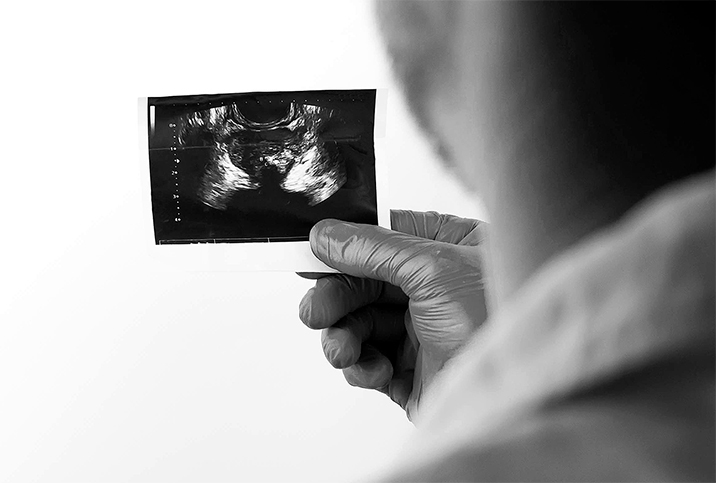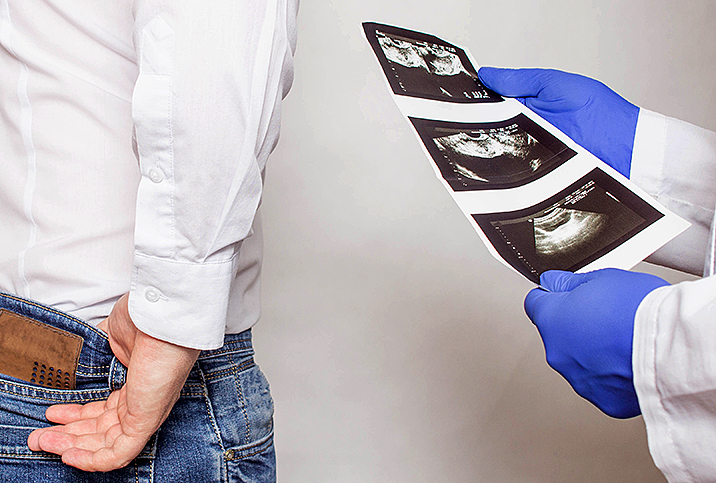The Facts About Prostate Conditions

You might not know much about your prostate. In fact, most men are unsure where their prostate is and what it does until they experience the negative effects of a prostate condition.
For men who are out of the loop, your prostate is a walnut-size gland that sits in front of your rectum and below your bladder. It surrounds part of your urethra and creates some of the fluid in your semen, among other functions.
Most prostate conditions come with age and are typically benign, though they can cause you to experience considerable pain and discomfort. In addition, you may experience urinary problems and/or sexual dysfunction when your prostate is not healthy.
Prostate health at a glance
According to the American Cancer Society, almost 250,000 American men will develop prostate cancer in 2021, and about 34,000 will die of the disease. But that's the extreme when it comes to the prostate. Beyond cancer, men may also face conditions like benign prostatic hyperplasia (BPH) and prostatitis, which can greatly diminish their quality of life and contribute to infections of the bladder, urinary tract and kidneys.
Several factors affect your prostate health. Age, of course, is one. Men older than 50 are much more likely to experience negative prostate health effects than men younger than 50. In fact, the highest percentage of men who experience poor prostate health are between the ages of 65 and 74.
Race can also have an impact on your prostate health. Black men, for example, have a greater risk of developing prostate problems than men of any other race, while Asian and Pacific Islanders have the least risk of adverse prostate health.
The reasons why Black men are more susceptible to developing serious prostate conditions like cancer—they have a 50 percent greater chance of getting prostate cancer and double the risk of dying from it than men of other races—are complex, and still not fully understood. After Black men turn 50, it's recommended they get regular screenings for any prostate irregularities, which can lead to the early detection and treatment of cancer.
Prostatitis
Prostatitis occurs when your prostate gland gets inflamed and swollen, and its most common symptoms are difficulty urinating or experiencing pain when you urinate. Other symptoms you might have include:
- Urinating frequently, especially at night
- Experiencing an urgent need to urinate
- Urinating cloudy urine
- Urinating bloody urine
- Experiencing lower back, abdomen or groin pain
- Experiencing penile or testicle discomfort or pain
- Experiencing painful ejaculation
- Feeling like you have the flu
Although you can develop prostatitis at any age, it is more likely if you are younger than 50. Prostatitis symptoms may appear suddenly, or they may develop over time, and the condition can sometimes resolve quickly with or without treatment, but you may experience symptoms of prostatitis for a longer period of time (months) or have recurrences (chronic prostatitis).
If you experience any of the symptoms associated with prostatitis, see your primary care doctor, who may not be able to pinpoint an exact cause for your prostatitis but can check for the known causes.
Prostatitis may be caused by a bacterial infection (acute bacterial prostatitis), which typically occurs when common urine bacteria leaks into your prostate and can be treated with antibiotics. If antibiotic treatment is successful, you may never develop prostatitis again, but if it doesn't work, you may develop chronic bacterial prostatitis that is recurring or difficult to treat.
You are at an increased risk of developing bacterial prostatitis if you recently had a bladder infection or had a catheter placed.
Risk factors for other types of prostatitis include having:
- Pelvic injuries (horseback riding, bicycling, etc.)
- Previous prostatitis
- HIV/AIDS
- Prostate biopsies
- Urinary tract infections
While it does not appear that prostatitis leads to the development of prostate cancer, you can experience some complications including epididymitis (inflammation of the epididymis, a coiled tube attached to the testicle), blood bacterial infection, an abscess in the prostate, changes in the semen and, potentially, infertility.
Nonbacterial prostatitis requires other treatments to give you relief, including:
- Alpha blockers to relax the muscles at the base of your bladder and around your prostate
- Prostate massage to ease the pressure by draining fluid from your prostate ducts (with or without physiotherapy)
- Anti-inflammatory medications
- Muscle relaxers
Lifestyle changes can help relieve prostatitis. Up first, diet. Eliminate sodas and alcohol, which can aggravate prostatitis. Add more fresh and frozen vegetables and fruits to your diet, along with whole grains and lean proteins such as fish and chicken. Drink more water (avoid sugary sports drinks).
Additionally, you may want to avoid cycling as a form of exercise. Poorly designed or incorrectly sized bicycle seats may put excessive pressure on your perineum and pelvic floor muscles, which can worsen symptoms.
Benign prostatic hyperplasia
Benign prostatic hyperplasia (BPH) is a noncancerous enlargement of the prostate related to your prostate's normal growth cycles, the first of which occurs when you enter puberty, at which time your prostate doubles in size. The prostate's second growth cycle begins when you are in your mid-20s and will continue for most of your life. It is during this second growth cycle that BPH most commonly occurs.
As your prostate undergoes its second growth cycle, it can press against your urethra and narrow it. Additionally, your bladder wall thickens, which increases the possibility that your bladder loses its ability to fully empty. These two conditions—a narrower urethra and retaining urine—are responsible for many of the problems associated with BPH. Almost 50 percent of men ages 51 to 60 have BPH, and approximately 90 percent of men 80 or older are affected by it. You are more at risk for BPH if you have a family history of the condition, erectile dysfunction, are obese or lead a sedentary lifestyle.
The good news: BPH is not prostate cancer and will not cause it. You can, however, have BPH and prostate cancer simultaneously.
BPH will directly impact your bladder. You may experience very frequent urges to urinate (every hour or two), especially at night. You may experience other symptoms, as well, such as:
- Feeling like your bladder is still full after urinating
- Difficulty starting and stopping urine flow
- Having a weak urine flow
- Having to start and stop urine flow more than once
- Straining to urinate
A severe case of BPH may restrict the ability to urinate at all. If this happens, or if it hurts to urinate or you have blood in your urine, you need to seek medical attention.
Your primary care doctor can help alleviate some of the symptoms of BPH in a couple of ways: alpha blockers to relax your bladder and prostate muscles, which will reduce urethra blockage and facilitate urine flow, and 5-alpha reductase inhibitors to block DHT product, which will shrink your prostate, increase the flow of urine and decrease further BPH complications.
BPH will not go away and can have adverse effects on your life. For example, men with BPH are more prone to developing bladder infections and can suffer from kidney damage.
The causes of BPH are not definite, but some speculation says it hinges on your testicles and your age. Why? Because males who had their testicles surgically removed before they entered puberty do not develop BPH. The testicles are responsible for producing the hormone testosterone. However, men also produce very small amounts of estrogen. Testosterone levels drop as you age, which creates a higher level of estrogen. Some evidence suggests that these higher levels of estrogen give a boost to the second prostate growth cycle.
Another factor that may come into play with BPH is the hormone dihydrotestosterone (DHT). Even though your testosterone levels drop as you age, DHT continues to increase in the prostate, which may fuel prostate cell growth.
Prostate cancer
Prostate cancer is the most serious threat to your prostate health. Cancer cells in your prostate can spread regionally (to nearby organs and lymph nodes) or distantly (to the lungs, liver or kidneys). Both are to be avoided.
One tool to detect prostate cancer (or other prostate issues) is the prostate exam. Guidelines vary as to when to begin the exams (here's what the American Cancer Society says), and it largely depends on your risk factors and family history. You and your doctor can arrive at the best exam schedule for you. At a minimum, a prostate exam includes a digital rectal exam (DRE), during which your doctor inserts a gloved and lubricated finger into your rectum to feel your prostate for any abnormalities.
Another component is a prostate-specific antigen (PSA) test, in which your blood is drawn and analyzed for its level of PSA, a protein that exists solely in the prostate. If your prostate is healthy, your PSA levels will be low, fewer than 4 nanograms of PSA per milliliter of blood. However, if your PSA levels are high—between 4 and 10 nanograms per milliliter (and definitely higher than 10)—your doctor may seek further testing.
It is important to note, though, that high PSA levels are not always an indication of prostate cancer. Research has suggested about 70 percent of men with increased serum PSA levels did not have prostate cancer. However, the exams are important and the results will help guide your doctor to the next steps in assessing your health. If you have prostatitis, for example, your PSA levels will be elevated. An increase in PSA simply tells your doctor that your prostate health is compromised, and prostate cancer may be one of the reasons. If your doctor deems it necessary, you will be referred to a urologist for an ultrasound, biopsy or CT scan.
If you have prostate cancer, it will be graded (assessed on its aggressiveness) and staged (assessed on its spread). Your urologist will recommend treatment based on the grade and stage of your prostate cancer.
The good news about prostate cancer is that it can be very successfully treated in its earliest stages when it is localized in the prostate. Treatment typically entails surgery, radiation or both. More advanced stages of cancer, however, become more difficult when it comes to treatment. If your prostate cancer has spread regionally, you have a high probability of complete recovery; the five-year survival rate drops significantly for cases that have spread distantly.
Keeping your prostate healthy
You can help keep your prostate healthy with a couple of lifestyle changes, both for specific conditions and for overall health. As mentioned for the management of prostatitis, consider altering your diet. Avoid loading up on sugar and sodium and eliminate or reduce the amount of red meat you eat. Instead, incorporate lean proteins (beans, eggs, fish and chicken) into your diet. Eat plenty of vegetables every day. Limit dairy products, but eat moderate amounts of nuts and healthy oils.
Another way to maintain your prostate health is to exercise. Exercise, especially aerobic, helps you maintain a healthy weight and regulate hormone production, which can help with prostate health. Try to incorporate a 30- to 45-minute brisk walk into your daily routine. If you can walk outside instead of inside on a treadmill, you will find that nature (particularly vitamin D) has amazing benefits for your emotional and mental health, which can also translate to better prostate health.


















